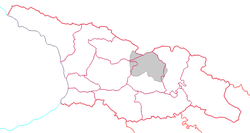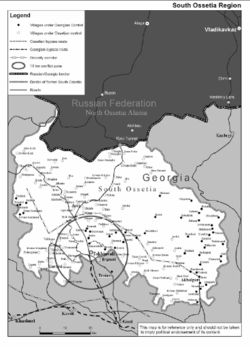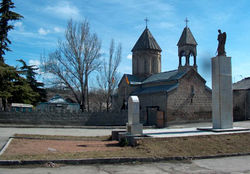South Ossetia
2007 Schools Wikipedia Selection. Related subjects: Countries; European Countries
| Хуссар Ирыстон სამხრეთ ოსეთის ავტონომიური ოლქი South Ossetia |
|||||
|
|||||
| Anthem: (Unknown) | |||||
| Capital | Tskhinvali | ||||
|---|---|---|---|---|---|
| Largest city | nao sei | ||||
| Official languages | Ossetian, Russian, Georgian | ||||
| Government | De facto separatist | ||||
| - President | Eduard Djabeevich Kokoity | ||||
| - Prime Minister | Yury Morozov | ||||
| Independence | |||||
| - Declared | November 28, 1991 | ||||
| - Recognition | unrecognized | ||||
| Area | |||||
| - Total | km² sq mi |
||||
| Population | |||||
| - 2004 estimate | 70,000 ( n/a) | ||||
| - n/a census | n/a | ||||
| - Density | 18/km² ( n/a) n/a/sq mi |
||||
| Currency | Russian ruble, Georgian lari1 ( n/a) |
||||
| Time zone | ( UTC+3) | ||||
| Internet TLD | |||||
| 1 Used exclusively in Georgian-populated areas. | |||||
South Ossetia ( Ossetian: Республикӕ Хуссар Ирыстон, Respublikæ Xussar Iryston; Russian: Южная Осетия, Yuzhnaya Osetiya; Georgian: სამხრეთ ოსეთის ავტონომიური ოლქი, Samkhret Oseti ) is a self-proclaimed republic within the internationally recognized borders of Georgia. Although this former Soviet autonomous oblast (region) has declared its independence and is in de facto control of significant part of the region, its separation from Georgia has not been recognized by any other country and is regarded a de jure part of the Georgian region ( mkhare) of Shida Kartli. Georgia does not recognise the region as a distinct entity, instead referring to it by either the medieval name of Samachablo or, more recently, Tskhinvali region (after the republic's capital). The republic has held a second independence referendum on November 12, 2006, after its first referendum in 1992 was not recognized by the international community as valid.. As expected the referendum turned out a majority for independence from Georgia. However, it is not recognized internationally by the European Union, OSCE and the United States, given the lack of ethnic Georgian participation.
History
Medieval and early modern period
The Ossetians are originally descendants of Iranian-speaking tribes from Central Asia. They became Christians during the early Middle Ages, under Georgian influence. Under Mongol rule, they were pushed out of their medieval homeland south of the Don river in present-day Russia and part migrated towards and over the Caucasus mountains, to Georgia where they formed three distinct territorial entities. Digor in the west came under the influence of the neighboring Kabard people, who introduced Islam. Tualläg in the south became what is now South Ossetia, part of the historical Georgian principality of Samachablo where Ossetians found refuge from Mongol invaders. Iron in the north became what is now North Ossetia, under Russian rule from 1767. Most Ossetians are now Christian (approximately 61%); there is also a significant Muslim minority.
South Ossetia under Russia and the Soviet Union
The modern-day South Ossetia was annexed by Russia in 1801, along with Georgia proper, and absorbed into the Russian Empire. Following the Russian Revolution, South Ossetia became a part of the Menshevik Georgian Democratic Republic, while the north became a part of the Terek Soviet Republic. The area saw brief clashes between the Georgian governmental forces and Ossetians led by Ossetian and Georgian bolsheviks in 1920.
The Soviet Georgian government established by the Russian 11th Red Army in 1921, created the South Ossetian Autonomous Oblast (i.e. district) in April 1922. Although the Ossetians had its own language ( Ossetian), Russian and Georgian were administrative/state languages. At present, Russian is the only administrative language used by the separatist government in Tskhinvali. In the Soviet time, under the rule of Georgia's government, it enjoyed some degree of autonomy, including to practice ( Ossetian) language and teach it in schools.
Georgian-Ossetian conflict
The tensions in the region began to rise amid the rising nationalism among both Georgians and Ossetians in 1989. Prior to this, the two communities had been living in peace with each other except for the episode in 1920. Both ethnicities have had a high level of interaction and high rates of intermarriages.
In the same year, the influential South Ossetian Popular Front (Ademon Nykhas) demanded unification with North Ossetia as a measure to defend Ossetian autonomy. On 10 November 1989, the South Ossetian Supreme Soviet approved a decision to unite South Ossetia with the North Ossetian ASSR, part of Russia. A day later, the Georgian parliament revoked the decision and abolished South Ossetian autonomy. Additionally, the parliament authorized the suppression of newspapers and demonstrations.
Following Georgia's independence in 1991 under the nationalist leader Zviad Gamsakhurdia, the Georgian government declared Georgian to be the only administrative language throughout the country (Georgian was a state/administrative language throughout the soviet time along with Russian and it was written so both in the 1936 and 1979 constitutions of Georgian Soviet Socialists Republic). This caused great concern in South Ossetia, whose leaders demanded that Ossetian become the language of their state. The Ossetian minority continued to seek greater levels of autonomy, but were faced with increasing nationalist sentiment among the Georgian majority. Violent conflict broke out towards the end of 1991 during which many South Ossetian villages were attacked and burned down as well as Georgian houses and schools in Tskhinvali, the capital of South Ossetia. As a result, approximately 1,000 died and 60,000-100,000 refugees fled the region, most across the border into North Ossetia or into Georgia proper. Many South Ossetians were resettled in uninhabited areas of North Ossetia from which the Ingush had been expelled by Stalin in 1944, leading to conflicts between Ossetians and Ingush over the right of residence in former Ingush territory. Only 15% of the Ossetian population now lives in South Ossetia.
In 1992, Georgia was forced to accept a ceasefire to avoid a large scale confrontation with Russia. The government of Georgia and South Ossetian separatists reached an agreement to avoid the use of force against one another, and Georgia pledged not to impose sanctions against South Ossetia. A peacekeeping force of Ossetians, Russians and Georgians was established. On November 6 1992, the Organization for Security and Cooperation in Europe (OSCE) set up a Mission in Georgia to monitor the peacekeeping operation. From then, until mid-2004 South Ossetia was generally peaceful. In June 2004, tensions began to rise as the Georgian authorities strengthened their efforts against smuggling in the region. Hostage takings, shootouts and occasional bombings left dozens dead and wounded. A ceasefire deal was reached on August 13 though it was repeatedly violated. Presently the situation is tense though largely peaceful, although Moscow and Tskhinvali view the recent Georgian arms build-up with concern. In the last year or so Georgia has purchased SU-25 fighter bombers from Republic of Macedonia and Bulgaria, as well as Mi-8 "Hip" helicopters from Ukraine, and its army is being trained by US Marine instructors. The Georgian government protests against the continually increasing Russian economic and political presence in the region, as well as the uncontrolled military of the South Ossetian side.
Politics
| Georgian-Russian relations |
|
Events
Primary parties involved |
The Republic of South Ossetia is not a territorially contiguous entity. It is, instead, something of a checkerboard of Georgian-inhabited and Ossetian-inhabited towns and villages in an arc around the largely Ossetian city of Tskhinvali. The capital and most of the other Ossetian-inhabited communities are governed by the separatist government in Tskhinvali, while the Georgian-inhabited villages are governed by the Georgian government. This close proximity and the intermixing of the two communities has made the conflict in South Ossetia particularly dangerous, as any attempt to create an ethnically pure territory would necessarily have to involve population transfer on a large scale.
The political dispute has, however, yet to be resolved and the South Ossetian separatist authorities still govern the region with effective independence from Tbilisi. Although talks have been held periodically between the two sides, little progress was made under the government of Eduard Shevardnadze ( 1993– 2003). His successor Mikheil Saakashvili (elected 2004) made the reassertion of Georgian governmental authority a political priority. Having successfully put an end to the de facto independence of the southwestern province of Ajaria in May 2004, he pledged to seek a similar solution in South Ossetia. After the 2004 clashes, the Georgian government has intensified its efforts to bring the problem to international attention. On January 25, 2005, President Saakashvili presented a Georgian vision for resolving the South Ossetian conflict at the Parliamentary Assembly of the Council of Europe (PACE) session in Strasbourg. Late in October, the U.S. Government and the OSCE expressed their support to the Georgian action plan presented by Prime Minister Zurab Noghaideli at the OSCE Permanent Council at Vienna on October 27, 2005. On December 6, the OSCE Ministerial Council in Ljubljana unanimously adopted a resolution supporting the Georgian peace plan which was subsequently rejected by the South Ossetian de facto authorities.
On August 26, 2006, the high-ranking delegation of the United States Senators led by the Arizona Senator John McCain paid a visit to the Georgian-Ossetian conflict zone. The group visited Tskhinvali and met with the de facto leader Eduard Kokoity. Speaking about his visit to Tskhinvali, Senator McCain said that the trip was "not very productive." Senator McCain said:
| Because there was not a direct response to our questions about why OSCE has been blocked from doing its job; why there has been no progress on peace initiatives from Georgia, from the UN, from the OSCE, from other organizations - there has been no progress. I think that the attitude there is best described by what you see by driving in [Tskhinvali]: a very large billboard with a picture of Vladimir Putin on it, which says 'Vladimir Putin Our President'. I do not believe that Vladimir Putin is now, or ever should be, the President of sovereign Georgian soil. |
Two days later, on August 28, Senator Richard Lugar, then visiting Georgia's capital Tbilisi, joined the Georgian politicians in criticism of the Russian peacekeeping mission, stating that "the U.S. administration supports the Georgian government’s insistence on the withdrawal of Russian peacekeepers from the conflict zones in Abkhazia and the Tskhinvali district."
On September 11, 2006, the South Ossetian Information and Press Committee announced that the republic will hold an independence referendum (the first referendum was not recognized by the international community as valid in 1992 ) on November 12, 2006. The voters will decide on whether or not South Ossetia "should preserve its present de facto status of an independent state". Georgia denounced the move as a "political absurdity". However, On September 13, 2006, the Council of Europe (CoE) Secretary General Terry Davis commented on the problem, stating that
| The secessionist authorities of the South Ossetian region of Georgia are wasting time and effort on the organisation of a "referendum on independence" in November... I do not think that anyone will recognise the result of such a referendum. If the people in power in South Ossetia are genuinely committed to the interest of the people they claim to represent, they should engage in meaningful negotiations with the Georgian government in order to find a peaceful, internationally accepted outcome. |
On September 13, 2006 EU Special Representative to the South Caucasus, Peter Semneby, while visiting Moscow, said: "results of the South Ossetian independence referendum will have no meaning for the European Union". Peter Semneby also added that this referendum will not contribute to the peaceful conflict resolution process in South Ossetia
On October 5, 2006, Javier Solana, the High Representative for the Common Foreign and Security Policy of the European Union, ruled out the possibility of replacing the Russian peacekeepers with the EU force." However, on October 10, EU South Caucasus envoy Peter Semneby admitted that "Russia's actions in the Georgia spy row have damaged its credibility as a neutral peacekeeper in the EU's Black Sea neighbourhood."
South Ossetians nearly unanimously approved a referendum on November 12, 2006 opting for independence from Georgia. The referendum was hugely popular, winning between 98 and 99 percent of the ballots, flag waving and celebration marked were seen across South Ossetia, but elsewhere observers were less enthusiastic. International critics claimed that the move could worsen regional tensions, and the Tblisis government thoroughly discounted the results. "Everybody needs to understand, once and for all, that no amount of referendums or elections will move Georgia to give up that which belongs to the Georgian people by God's will," declared Georgi Tsagareishvili, leader of the Industralist's bloc in Georgia's parliament. On November 13, Terry Davis, head of the 46-nation Council of Europe, called the referendum on "independence" as "unnecessary, unhelpful and unfair" because ethnic Georgians were not given the right to vote in it.
Geography
South Ossetia covers an area of about 3,900km² on the southern side of the Caucasus, separated by the mountains from the more populous North Ossetia (part of Russia) and extending southwards almost to the Mtkvari river in Georgia. It is extremely mountainous, with most of the region lying over 1,000m (3,300ft) above sea level. Its economy is primarily agricultural, although less than 10% of South Ossetia's land area is cultivated, with cereals, fruit and vines the major produce. Forestry and cattle industries are also maintained. A number of industrial facilities also exist, particularly around the capital Tskhinvali.
Economy
Following a war with Georgia in the 1990s, South Ossetia has struggled economically. Employment and supplies are scarce. Additionally, Georgia cut off supplies of electricity to the region, which forced the South Ossetian government to run an electric cable through North Ossetia. The majority of the population survives on subsistence farming. In addition to its economic problems, unclear political perspectives, thousands of refugees, and an illegal drug and arms trade have made the region unstable again in the last few years. Virtually the only significant economic asset that South Ossetia possesses is control of the Roki Tunnel that links Russia and Georgia, from which the South Ossetian government reportedly obtains as much as a third of its budget by levying customs duties on freight traffic.




